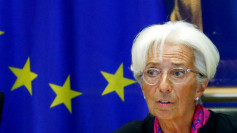Two straight days of Wall Street meltdowns have seen the benchmark Dow Jones Industrial Average plunge by a combined 700 points, and infected Asian markets on both Monday and Tuesday.
Asian shares closed mostly lower Wednesday after the steepest drop in oil prices in more than three years goaded Wall Street investors into a frenzy of selling over the past two days.
Japan's benchmark Nikkei 225 stumbled 0.1 percent to 21,779.22 in early Wednesday trading. Australia's S&P/ASX 200 shed 1.3 percent to 5,759.90. South Korea's KOSPI lost 0.4 percent at 2,062.34. Hong Kong's Hang Seng yielded 0.4 percent to 25,684.65, while the Shanghai Composite closed 0.4 percent lower at 2,644.64. Shares were also lower in Taiwan.
It was much the same story for Asian shares Tuesday. Asian stocks traded lower today following another tech-led slump on Wall Street. Key indices slid Asia-wide in an apparent contagion. The worst of Asia's losses, however, diminished on hopes talks initiated today to stop the U.S.-China trade war might fulfil its promise. As a consequence, Treasury yields fell while the dollar slipped from an 18-month high.
Stocks shook-off their lows on a report China's Vice Premier Liu He will visit the U.S. to pave the way for a meeting between president Donald Trump and president Xi Jinping at the sidelines of the G20 summit on Nov. 30 in Argentina.
Hopes, however distant, of a resumption in trade talks, helped shares at the Shanghai and Shenzhen exchanges swing from declines of more than one percent to gains of the same magnitude. Hong Kong stocks erased a slide.
Elsewhere in Asia, the Australian and New Zealand dollars climbed on reports the previously mentioned report the U.S. and China might be moving closer toward resolving Trump's trade war.
The new Asian malady began in Wall Street where the Dow Jones Industrial Average fell an enormous 602 points on Monday in another day of extreme and unnerving volatility at U.S. equity markets.
Monday's huge losses bring the Dow's decline over the past two sessions to 804 points. The Dow closed at 25,387.18. The tech-heavy NASDAQ Composite retreated 2.8 percent to 7,200.87 and fell back into the correction territory it first entered during the October market rout.
The S&P 500 tech sector stumbled into correction territory, dropping 2% to 2,726.22 as financials tanked, led by Goldman Sachs. Goldman shares posted their biggest drop in seven years after news broke that Malaysia's finance minister is demanding a refund of fees paid to Goldman for its work in scandal-plagued state investment fund 1MDB.
Analysts blamed the new rout and weak investor sentiment on a sharp decline in Apple shares; a rise in the U.S. dollar and persistent worries about global trade, especially a ramped-up U.S. trade war.
The major indices hit their lows of the day in late-afternoon trading media reported the White House had circulated a draft report on auto tariffs that plans to impose a 25% tax on all luxury cars imported into the U.S.
Apple led the rout in tech, its shares falling by 5% after Lumentum Holdings, which makes technology for the iPhone's face-recognition feature, cut its outlook for its fiscal second quarter in 2019. Lumentum CEO Alan Lowe said one of its largest customers (Apple) asked the company to "materially reduce shipments" for its products. Shares of Lumentum plunged 33 percent at the news.
Apple renewed fall affected the broader technology sector. The Technology Select Sector SPDR dropped 3.5 percent. Alphabet and Amazon shares lost 2.7 percent and 4.3 percent, respectively. Amazon shares entered bear-market territory, falling by 20 percent from its 52-week high. Amazon was worth $1 trillion more than two months ago.
The S&P 500 tech sector is down more than 10 percent from its 52-week high. Nearly 70 percent of the stocks in the sector are in a correction. One analyst said the FAANG trade is dead and the market is struggling to find a replacement.






